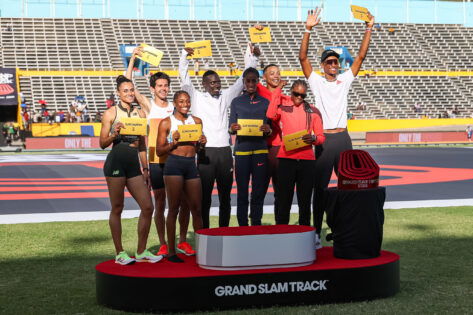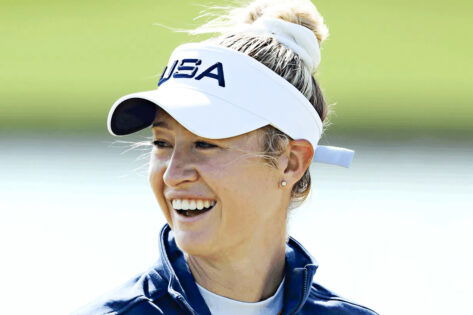“Grand Slam Track is the equivalent of UFC and Formula One.” That’s how Michael Johnson pitched it: bold, ambitious, maybe even a little audacious. After all, he was pumping in the big money into this professional track event. $12.6 million. He wanted to offer fans more than just those two weeks of Olympic fun once every four years. But enough of the preview. Because now that the 3-day-long Kingston Slam is wrapped, we can finally talk about the aftermath. So let’s put the points on the table. What worked? What wowed us? And what missed the mark?
To start off, Michael Johnson had researched the sport well. He knew people watched track during the Olympics for three reasons. The stakes, the stars, and the stories. Well, he brought all that on a single platter and dished out Grand Slam Track. Yes, it hit the nail on the head in terms of those big names that showed up. Gabby Tomas, Sydney McLaughlin-Levrone, Kenny Bednarek, Dalilah Muhammad, Dina Asher-Smith, and Fred Kerley, among others. It was a star-studded show, and the head-to-head clashes peaked the track drama fans wanted to see. But this reminds us, something was probably felt lacking.
Can track be saved without field?
Track and field, in layman’s terms, are joined at the hip. Yes, the two represent athletics together! And honestly, we did miss the field events at this 3-day gala in Kingston. Technically speaking, field events are very much a part of the Olympics, and the athletes there deserve the opportunities, the platform, and the money, too. Yes, we knew for a fact that Michael Johnson had been clear on his terms, “Grand Slam Track is track – that is what we’re doing. I am going to save what I think I can save.” But track and field is essentially a package, right? Perhaps by including the field side of things, too, the revolution could have felt a bit more complete.
Thanks to everyone who supported us for our very first @GrandSlamTrack slam! pic.twitter.com/5EyWq7qv1T
— Michael Johnson (@MJGold) April 7, 2025
Even if we see it from a star point of view, field events have been on fire lately. Especially after the Paris Olympics, there’s Ryan Crouser, the only Olympic three-peater to ever exist. We also have Tara Davis-Woodhall, whose shaped up to be quite the field sensation after her Paris Olympics long jump title. And of course, Armand aka Mondo Duplantis, the man who broke the Pole Vault world record 11 times. For fans, watching these field giants would’ve taken the Grand Slam Track experience to the next level. Just look at the buzz around Sydney McLaughlin-Levrone—all her fans who ever said she doesn’t race often were perhaps over the moon.
So, if GST and Michael Johnson really wanted to shake up the sport, including the field, it might have been a power move. Just imagine a Long Jump, Triple Jump race group or a Shot Put, Hammer group. Now that would have been quite amazing to watch, isn’t it?
Yes, the money reached, but the crowd didn’t
The Grand Slam Track delivered on its promise; it let the runners truly cash in. Emmanuel Wanyonyi, once a cattle herder forced to leave school, walked away as a Short Distance Slam champ with $100K in hand. Dylan Beard, still working shifts at Walmart, bagged $50K as the short hurdles silver medallist, without even a shoe sponsor. When Michael Johnson said, “We need to grow the sport. We need athletes to make more money,” this is exactly what he meant. Even Grant Fisher said, “I’ve never had a base salary from a series of races before, that’s entirely novel.”
But where was the crowd? Well, despite Michael Johnson’s math, “Every four years, [track and field] it’s the most popular sport on the planet. Then it drops off, but even in between, over 155 million people every year watch at least two track meets and 325 million people watch one,” the sea of empty seats at the National Stadium was impossible to ignore. Just 6000 of 35,000 filled on Day 1. It suggested that yes, the Grand Slam Track still has work to do in order to capture an audience. However, he accepted that with a pinch of salt. “Obviously, look, let’s be honest. We would love to see more spectators here, you know?”
The Grand Slam Track format is a hit, but where were the big guns?
The Grand Slam Track’s new and innovative format is a big hit! Why? Well, running two races is bringing a lot of versatility to athletes’ resumes. Plus, it’s giving fans the drama they need. We saw an 800m champ dominate the 1500m field like it was nothing. We saw Sydney hint at dipping her toes into everything from 100m hurdles to the 400m flat! So yes, the unique format is a hit! That’s the kind of track reform and shake-up we’d like to see more of.
Also, the Grand Slam Track touts itself as a premier event. Well, they do have the biggest prize purse of them all! But while they were calling themselves the ‘Formula One’ of the sport, where were the Ferraris? Point being, while the competition was fierce, the lineup missed some of the sport’s biggest names. No Noah Lyles. No Sha’Carri Richardson. No Letsile Tebogo, Grant Holloway, Shelly-Ann Fraser-Pryce, or Shericka Jackson, either. And that distance running lineup could have fired up with Jakob Ingebrigsten in the squad. So, when Michael Johnson talks about the best going head-to-head, the GST has to feature the big guns.
Overall, the Grand Slam Track was a grand attempt. But, just like most debut events, a few cracks are only normal, right? With Miami next, here’s hoping the Grand Slam Track pulls up its socks in the areas it visibly lacked. First up, the crowd. A packed stadium buzzing with energy is what will add life to the meet. Also, a few missing headliners this time. Let’s fix that. Also, some fans found a lot of dead air between the races broadcast to be pulling the energy down. A bit more streamlining there, maybe? Overall, it sounds like a win for track and field!
The post Michael Johnson’s Grand Slam Track Did ‘Save’ Track & Field but Had Some Things Wrong. Can They Change? appeared first on EssentiallySports.



